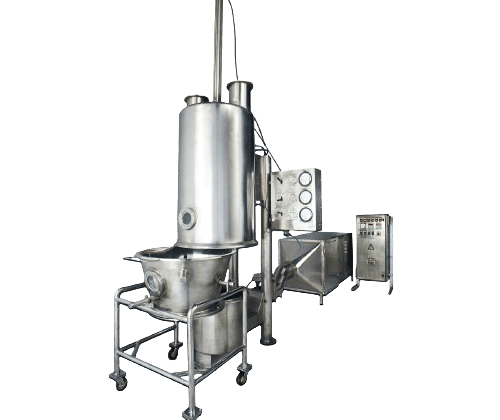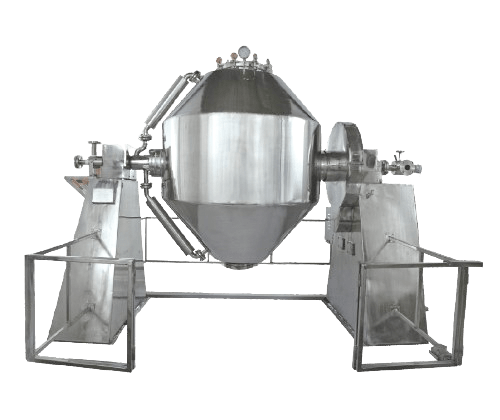The Complete Guide to Understanding How Fluid Bed Dryers Work
Fluid Bed Dryers are used to dry, wet granulated materials attained after the granulation process. The material is dried through the combination of (a) moisture diffusion from the inside of the granules and (b) the removal of moisture by forced-air convection. In this unit operation, the granulated material is fluidized by hot & dehumidified air to achieve efficient heat and mass transfer.
There are three critical inlet air parameters that affect the efficiency of the Process and the Quality of the product:
- Temperature
- Humidity
- Air Flow Rate
Features:
- Mono block construction – retarding chamber and filter bag chamber made in a single-piece construction to enhance GMP & promote hygienic cleaning.
- Solid Flow Sensor installed to detect leaks on filter bags to avoid material loss & air contamination.
- Intrinsically safe earthing arrangement.
- Inlet air-filtration system with primary. secondary and 0.3 microns HEPA filters.
- Pneumatic lifting/locking for product container with retarding chamber.
- Fully Automatic Bag shaking.
- Rear Chamber with heating coils and Inlet filter is to be mounted in the Technical Area (Remote Area)
- Blower/Motor to be mounted in the Technical Area (Remote Area)
- Inlet & Outlet dampers with pneumatic control valves.
- PLC-based control panels with Time vs. temperature, Control Batch Programming & batch data printouts.
Working Principles:
Fluid Bed Dryer is a batch operation in which the moist material is converted to a free-flowing fluidized state by means of an upward-flowing hot air stream. During this process, the entire surface of each particle is surrounded by hot air thus achieving a homogeneous distribution of temperature & thereby a rapid drying operation.
The air is drawn through a blower fan from outside & passed through 3 stages of filtration (pre, fine & HEPA) & heated with the help of steam coils & or electric heaters. The air then flows upwards through the material Inside the product container & absorbs the moisture from the material.
The filter bag assembly mounted above the container & retarding chamber keeps the material caught up in the flow of air which subsequently fall back into the container, by means of the outlet air damper as installed in the outlet duct.
The drying time depends on various factors such as physical properties of raw material, initial moisture content, type of moisture (free or inherent of water of crystallization) & the drying temperature.
Accessories:
- Retarding Chamber:
During the FBD operation, there is a tendency of generation of static electricity due to the agitation of material and the presence of steam & dust. However, the same is variable in quantity depending upon the material air velocity & the degree of dryness of the product. The retarding chamber is provided to settle the heavier particles in the product container. Also, outside the retarding chamber antistatic probe assembly is provided to absorb static electricity and to discharge the same to the earthling cable.
- Filter Bag & Sealing:
The filter bag is sealed with the help of an inflatable gasket held inside a SS ring which is inserted into the lower end of the filter bag & sandwiched between the retarding chamber & the filter housing The gasket material can be Silicon, Neoprene, or EPDM Food Grade rubbers. The basic function of the sealing is to prevent the product from escaping into the outlet air.
- Filter Bag Shaking Device:
The device is used for the removal of fine particles from the Filter Bag & thereby avoiding pressure drops across the filter. It consists of a wire rope & pulleys wherein one end of the wire rope is attached to a handle and the other end to the filter bag hanger. The filter hanger is held in place by the handle stopper & whenever the handle is released, jacked up & down the filter bag is compressed & stretched alternately. This operation can also be automated by means of a pneumatic cylinder.
Conclusion:
In conclusion, fluid bed dryers are crucial for drying wet granulated materials efficiently. They operate by fluidizing the material with hot, dehumidified air, allowing for effective heat and mass transfer. The key parameters affecting the process efficiency and product quality include temperature, humidity, and airflow rate. The design features of fluid bed dryers, such as mono block construction, solid flow sensor, and inlet air-filtration system, enhance their performance and hygiene. The working principle involves converting moist material into a free-flowing fluidized state using an upward-flowing hot air stream. Accessories like the retarding chamber, filter bag & sealing, and filter bag shaking device further optimize the drying process and ensure product quality. Overall, fluid bed dryers are essential in various industries for their rapid and efficient drying capabilities.



